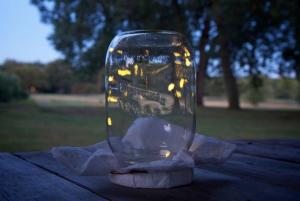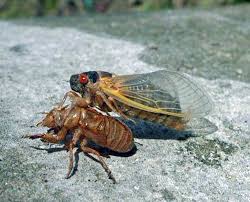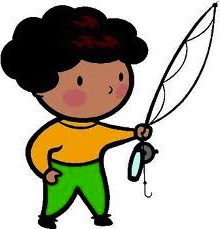 by Diane Schwartz, Get Kids Outside
by Diane Schwartz, Get Kids Outside
Summertime flies by so fast. Before you know it, back-to-school ads will start.
Enjoy the summer by giving your kids wonder-filled activities that will delight and engage them.
1. Catch a firefly or two or three in a jar: No insect says summer like the firefly. These gentle insects light up the night and the imaginations of kids. Male and female fireflies blink
on and off as a way of attracting each other for mating. Different species have different blinking patterns. To see this, capture some fireflies in a jar and count the gap between flashes and look for patterns. Gently release them and try with another set of fireflies. If they have different flash patterns, then it’s a different species.
2. Catch a cicada larvae and watch it morph overnight into a gorgeous flying machine. Cicadas usually start appearing in late July and early August. Their high-pitched singing ushers in the dog days of summer. Look for cicada larvae at the base of trees in the early evening. Gently place the larvae in a well-ventilated container with a few sticks or bark. In the morning, you will have a fully morphed cicada. Notice the exoskeleton left by the molting insect. Pretty cool. Observe this beautiful insect and then let it go. Later, listen for and try to find one sitting in a tree. They are very loud so you may have to hold your ears. They are the only insect capable of making such loud noises.
3. Make homemade ice cream in a bag. There is nothing better than eating something that you make from scratch. All it takes is ice, sugar, heavy cream, vanilla, rock salt and your favorite fruit or candy. The best part is you don’t have to crank and the kids can make a mess outside and toss the baggies. I like the recipe at www.spoonful.com. For the scientific approach go to www.scientificamerican.com. I love it when kids learn while they’re having fun.
4. Make a backyard water park with sprinklers, plastic tarps and buckets. Set up a sprinkler or two to make a water park in your backyard. A plastic tarp can make a great slip and slide and water balloons are always a hit. Get the entire neighborhood together to make this simple pleasure a real extravaganza.
5. Play outside at night. Too many kids do not get to experience the joy of playing outside at night. How else are you going to catch those fireflies? Be sure to let your kids experience the joy of summer at night. Have a campfire or cookout, take an evening stroll, catch fireflies, or play hide-and-seek. The summer lasts longer when you play outside at night.
6. Have a campfire. Whether in your backyard or at a campground, having a campfire is essential. Campfires are relaxing and cozy. Your kids will remember the stories that are shared around a campfire for a lifetime and they’ll really remember the food. Everything tasted better when it’s cooked on a fire outside.
 7. Eat a s’more: A s’more is the quintessential campfire treat. Just cook a marshmallow or two over a fire and sandwich them between two graham crackers and a piece of chocolate for a delicious campfire snack. Pudgy Pies are another favorite. To make one you need giant pie irons. We called them Tonka Toasters growing up and you can buy them at most outdoor stores. A Pudgy Pie is essentially a grilled cheese sandwich, only it’s cooked between the pie irons. Fillings vary. Pie filling was our favorite, just don’t put too much in the middle or the bread will break. You may burn one or two before getting it right, but that’s part of the fun.
7. Eat a s’more: A s’more is the quintessential campfire treat. Just cook a marshmallow or two over a fire and sandwich them between two graham crackers and a piece of chocolate for a delicious campfire snack. Pudgy Pies are another favorite. To make one you need giant pie irons. We called them Tonka Toasters growing up and you can buy them at most outdoor stores. A Pudgy Pie is essentially a grilled cheese sandwich, only it’s cooked between the pie irons. Fillings vary. Pie filling was our favorite, just don’t put too much in the middle or the bread will break. You may burn one or two before getting it right, but that’s part of the fun.
8. Go swimming in an old-fashioned swimming hole where you can use inner tubes and floaties. Bring along the noodles, inner tubes and floaties for old-fashioned fun at the beach. Devil’s Lake is a great place to swim because the water is clean and you can enjoy inner tubes. You can also chase minnows and find interesting rocks on the beach. While there is no life-guard on duty at many of these parks, the water is shallow enough so that you don’t have to worry too much. Plus, you can always swim with your kids. They will love you for it.
 9. Go to a Fair: Every county in Wisconsin, and most states, holds a fair between July and September every year. The year ends with a huge state fair. You can see animals, go on rides, play games or just walk around. I go just to see that donut machine that automatically drops the dough into a river of hot oil and flips them when they reach golden-brown perfection. It’s an engineering marvel and makes my day. True, this event is not free and food alone can rack up the costs. However, if you save up, you can manage a visit to the fair once a year. See http://www.wisconline.com for a list of all the Fairs in Wisconsin.
9. Go to a Fair: Every county in Wisconsin, and most states, holds a fair between July and September every year. The year ends with a huge state fair. You can see animals, go on rides, play games or just walk around. I go just to see that donut machine that automatically drops the dough into a river of hot oil and flips them when they reach golden-brown perfection. It’s an engineering marvel and makes my day. True, this event is not free and food alone can rack up the costs. However, if you save up, you can manage a visit to the fair once a year. See http://www.wisconline.com for a list of all the Fairs in Wisconsin.
10. Look for shooting stars: City folks will have to find a spot outside the city lights for this one, or just find a spot shielded from big lights. Lay down a blanket and stare up into the night sky. Imagine the galaxies and planets and the vastness of the universe. Tell stories and look for constellations like the big dipper. If you don’t know the constellations, then invent your own. But most of all just marvel at the beauty of the night sky and before you know it you’ll be saying, “Look, there’s a shooting star. Did you see it?”
Don’t forget to make a wish and relish your time with your kids this summer.
What summer activities are on your top 10 list?
Diane Schwartz is the founder of Get Kids Outside. She is passionate about getting kids outdoors and has taught more than 300 kids and their families the joys of biking, hiking and skiing. She is especially interested in increasing racial diversity in our parks and trails. In addition, she founded the Madison Area Women’s Outdoor Group in 2012. The group has over 300 members and has completed 128 outings.


































